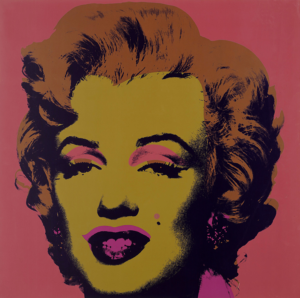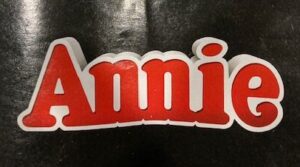
 *****Andy Warhol and his art could be considered a reaction to the miracle of automation and the assembly line: having a view towards the future that goes beyond that of corporate America. Seeing his original multicolor silkscreen prints, paintings, drawings, and photographs upfront and personal is most definitely an experience to remember in this outstanding exhibition at the Cleve Carney Museum of Art, at the McAninch Arts Center. Interactive exhibits, recreations, and videos created exclusively for the exhibition add to our insight into Warhol the artistic genius and an icon of pop culture. Bold primary colors and strikingly intense shades provide variations within canvases and prints that are frequently part of the same sequence. Theme and variation characterize the artworks closest to his graphic design training, although over time we observe just how much he wants to break free of convention by infusing motion into his work. The addition of psychedelic colors and undulating lines to his largely repetitive themes make his still images pop and glow and provide dimension.
*****Andy Warhol and his art could be considered a reaction to the miracle of automation and the assembly line: having a view towards the future that goes beyond that of corporate America. Seeing his original multicolor silkscreen prints, paintings, drawings, and photographs upfront and personal is most definitely an experience to remember in this outstanding exhibition at the Cleve Carney Museum of Art, at the McAninch Arts Center. Interactive exhibits, recreations, and videos created exclusively for the exhibition add to our insight into Warhol the artistic genius and an icon of pop culture. Bold primary colors and strikingly intense shades provide variations within canvases and prints that are frequently part of the same sequence. Theme and variation characterize the artworks closest to his graphic design training, although over time we observe just how much he wants to break free of convention by infusing motion into his work. The addition of psychedelic colors and undulating lines to his largely repetitive themes make his still images pop and glow and provide dimension.
This collection of art, artifacts, and personal history is a must see! Not only do we admire Warhol’s craft but also how the entire display was put together and interpreted. Expertly designed in chronology and thematics, the layout of the exhibit flows nicely and makes Warhol’s take on modernity, technology, and individualism merge with his fascination with fame, fortune, and Hollywood. The outer reaches of his distinctive imagery are featured as we tour the various rooms: the historical exhibit, his life in pop, his photographs, the interview magazines, and the nod to Studio 54: a club where well-heeled people go in NYC (as depicted by the outfits that they once wore). Especially intriguing is the small gallery on the second floor entitled “Silver Clouds”, an interactive experience which was the happy result of a dare. This is fun for adults and children alike.
In part, Warhol’s illness as a child with Sydenham’s chorea (a/k/a St. Vitus Dance) and his days of bedrest started him on the road to become a professional artist. Yet he almost lost his seat at the Carnegie Institute because of poor grades at a time when U.S. troops were returning at the end of World War II, and college seats needed to be made for them. However, he was allowed to stay and pursue his career path as a graphic designer when professors recognized his native talent. Yet this line of work didn’t satisfy him: He wanted to find more in life by being accepted and loved for his creative inspiration. In the transition from graphic designer to fine artist, Warhol expertly turned his individual experience with corporate culture into a common experience that other people could relate to. Growing up in a very poor household, he turned around the fact that he ate Campbell’s soup practically every day into a series of masterworks, for which he is ridiculously famous. And speaking of famous, of course we get to see the repetitive silkscreens of Marilyn Monroe! Do they make her look any prettier, or does she somehow become average by means of her face being everywhere?
A maverick in many senses of the word, Warhol never really moved beyond self-absorption except that when he honed his artistic skills, he was able to hit a nerve of universality within the larger reaches of American culture. His nod to consumerism and his rebellion against it made him become widely popular—and ironically a corporate success. The freedom expressed in his later work almost makes light of his earlier creations. Thus, we are left not only with Warhol’s legacy in pop but with an image of modernity that became diffused throughout American culture at-large and subsequently embraced by all. Now it’s your turn to embrace this seemingly larger-than-life figure by purchasing tickets to attend this wonderful exhibition that includes several collections of Warhol’s art and his portfolios. Above all, kudos to all those who designed the installation. It is great to take note their artistry and how well Warhol’s works have been placed in historical and biographical context.*
Expect to spend a morning or afternoon winding through the galleries, a total of 11,000 square feet of exhibition space. Having said that, my guest and I moved on to the DuPage County Historical Museum, in nearby Wheaton, for a change of pace. To our surprise, there was a tiny replica of the Warhol publicity within the huge miniature train display in the museum’s basement!
“Warhol”: Featuring “Andy Warhol Portfolios: A Life in Pop | Works from the Bank of America Collection” is at the Cleve Carney Museum of Art, McAninch Arts Center, at the College of DuPage, 425 Fawell Blvd., Glen Ellyn, Illinois, through September 10, 2023.
 Exhibit hours (subject to change):
Exhibit hours (subject to change):
Tuesday through Sunday: 10 a.m. to 6 p.m.
Extended hours on Thursdays, to 9 p.m.
Tickets range from $12 to $45 (plus fees of $4.50 per ticket) and can be purchased online https://www.theccma.org/warhol-tickets.
Group rate tickets (for 20 or more) are available. Email or call to make your group reservation:
grouptix@cod.edu or (630) 942-3026. For more information, go to: https://www.theccma.org/groups-info.
For more information about the exhibit and its sponsors, see https://www.theccma.org/warhol.
For those interested in visiting the DuPage County Historical Museum to see local historical artifacts, their address is 102 E Wesley St, Wheaton, Illinois. Their hours are: Tuesday-Friday: 10:30 a.m.-4:00 p.m. and Saturday: 12:00 p.m. -4:00 p.m. Admission is free; donations are accepted.
*Note that Warhol’s snapshot approach to photography largely serves as a guide for his drawings and is not high art. His photos become significant in the context of his life and his larger body of work.






More Stories
“The Elements”, Music of the Baroque reviewed by Julia W. Rath
Bernie G. Yvon Scholarships for 2024-2025
“An Experience That Makes a Difference”